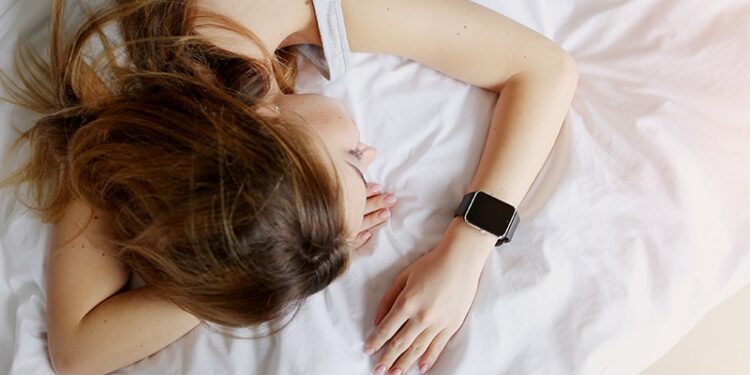Changes in sleep metrics detected with wearable technology could serve as an inflammation marker and potentially predict inflammatory bowel disease (IBD) flareups, regardless of whether a patient has symptoms, an observational study suggested.
Sleep data from 101 study participants over a mean duration of about 228 days revealed that altered sleep architecture was only apparent when inflammation was present — symptoms alone did not impact sleep cycles or signal inflammation.
“We thought symptoms might have an impact on sleep, but interestingly, our data showed that measurable changes like reduced rapid eye movement (REM) sleep and increased light sleep only occurred during periods of active inflammation,” Robert Hirten, MD, associate professor of Medicine (Gastroenterology), and Artificial Intelligence and Human Health, at the Icahn School of Medicine at Mount Sinai, New York City, told Medscape Medical News.
“It was also interesting to see distinct patterns in sleep metrics begin to shift over the 45 days before a flare, suggesting the potential for sleep to serve as an early indicator of disease activity,” he added.
“Sleep is often overlooked in the management of IBD, but it may provide valuable insights into a patient’s underlying disease state,” he said. “While sleep monitoring isn’t yet a standard part of IBD care, this study highlights its potential as a noninvasive window into disease activity, and a promising area for future clinical integration.”
The study was published online in Clinical Gastroenterology and Hepatology.
Less REM Sleep, More Light Sleep
Researchers assessed the impact of inflammation and symptoms on sleep architecture in IBD by analyzing data from 101 individuals who answered daily disease activity surveys and wore a wearable device.
The mean age of participants was 41 years and 65.3% were women. Sixty-three participants (62.4%) had Crohn’s disease (CD) and 38 (37.6%) had ulcerative colitis (UC).
Almost 40 (39.6%) participants used an Apple Watch; 50 (49.5%) used a Fitbit; and 11 (10.9%) used an Oura ring. Sleep architecture, sleep efficiency, and total hours asleep were collected from the devices. Participants were encouraged to wear their devices for at least 4 days per week and 8 hours per day and were not required to wear them at night. Participants provided data by linking their devices to ehive, Mount Sinai’s custom app.
Daily clinical disease activity was assessed using the UC or CD Patient Reported Outcome-2 survey. Participants were asked to answer at least four daily surveys each week.
Associations between sleep metrics and periods of symptomatic and inflammatory flares, and combinations of symptomatic and inflammatory activity, were compared to periods of symptomatic and inflammatory remission.
Furthermore, researchers explored the rate of change in sleep metrics for 45 days before and after inflammatory and symptomatic flares.
Participants contributed a mean duration of 228.16 nights of wearable data. During active inflammation, they spent a lower percentage of sleep time in REM (20% vs 21.59%) and a greater percentage of sleep time in light sleep (62.23% vs 59.95%) than during inflammatory remission. No differences were observed in the mean percentage of time in deep sleep, sleep efficiency, or total time asleep.
During symptomatic flares, there were no differences in the percentage of sleep time in REM sleep, deep sleep, light sleep, or sleep efficiency compared with periods of inflammatory remission. However, participants slept less overall during symptomatic flares compared with during symptomatic remission.
Compared with during asymptomatic and uninflamed periods, during asymptomatic but inflamed periods, participants spent a lower percentage of time in REM sleep, and more time in light sleep; however, there were no differences in sleep efficiency or total time asleep.
Similarly, participants had more light sleep and less REM sleep during symptomatic and inflammatory flares than during asymptomatic and uninflamed periods — but there were no differences in the percentage of time spent in deep sleep, in sleep efficiency, and the total time asleep.
Symptomatic flares alone, without inflammation, did not impact sleep metrics, the researchers concluded. However, periods with active inflammation were associated with a significantly smaller percentage of sleep time in REM sleep and a greater percentage of sleep time in light sleep.
The team also performed longitudinal mapping of sleep patterns before, during, and after disease exacerbations by analyzing sleep data for 6 weeks before and 6 weeks after flare episodes.
They found that sleep disturbances significantly worsen leading up to inflammatory flares and improve afterward, suggesting that sleep changes may signal upcoming increased disease activity. Evaluating the intersection of inflammatory and symptomatic flares, altered sleep architecture was only evident when inflammation was present.
“These findings raise important questions about whether intervening on sleep can actually impact inflammation or disease trajectory in IBD,” Hirten said. “Next steps include studying whether targeted sleep interventions can improve both sleep and IBD outcomes.”
While this research is still in the early stages, he said, “it suggests that sleep may have a relationship with inflammatory activity in IBD. For patients, it reinforces the value of paying attention to sleep changes.”
The findings also show the potential of wearable devices to guide more personalized monitoring, he added. “More work is needed before sleep metrics can be used routinely in clinical decision-making.”
Validates the Use of Wearables
Commenting on the study for Medscape Medical News, Michael Mintz, MD, a gastroenterologist at Weill Cornell Medicine and NewYork-Presbyterian in New York City, observed, “Gastrointestinal symptoms often do not correlate with objective disease activity in IBD, creating a diagnostic challenge for gastroenterologists. Burdensome, expensive, and/or invasive testing, such as colonoscopies, stool tests, or imaging, are frequently required to monitor disease activity.”
“This study is a first step in objectively monitoring inflammation in a patient-centric way that does not create undue burden to our patients,” he said. “It also provides longitudinal data that suggests changes in sleep patterns can pre-date disease flares, which ideally can lead to earlier intervention to prevent disease complications.”
Like Hirten, he noted that clinical decisions, such as changing IBD therapy, should not be based on the results of this study. “Rather this provides validation that wearable technology can provide useful objective data that correlates with disease activity.”
Furthermore, he said, it is not clear whether analyzing sleep data is a cost-effective way of monitoring IBD disease activity, or whether that data should be used alone or in combination with other objective disease markers, to influence clinical decision-making.
“This study provides proof of concept that there is a relationship between sleep characteristics and objective inflammation, but further studies are needed,” he said. “I am hopeful that this technology will give us another tool that we can use in clinical practice to monitor disease activity and improve outcomes in a way that is comfortable and convenient for our patients.”
This study was supported by a grant to Hirten from the US National Institutes of Health. Hirten reported receiving consulting fees from Bristol Meyers Squibb, AbbVie; stock options from Salvo Health; and research support from Janssen, Intralytix, EnLiSense, Crohn’s and Colitis Foundation. Mintz declared no competing interests.
Marilynn Larkin, MA, is an award-winning medical writer and editor whose work has appeared in numerous publications, including Medscape Medical News and its sister publication MDedge, The Lancet (where she was a contributing editor), and Reuters Health.
Source link : https://www.medscape.com/viewarticle/sleep-changes-ibd-could-signal-inflammation-flareups-2025a1000jlz?src=rss
Author :
Publish date : 2025-07-24 11:52:00
Copyright for syndicated content belongs to the linked Source.





